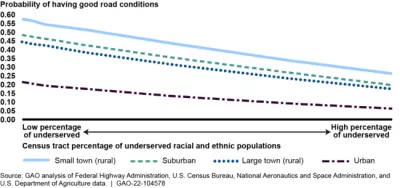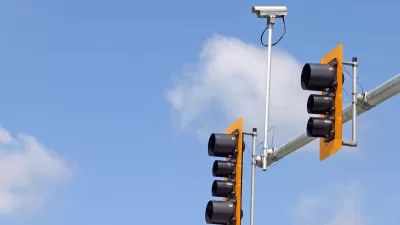The Federal Highway Administration doesn’t analyze the condition of pavement on U.S. highways. If it did, it would find vast inequities depending on which communities live nearby highway infrastructure.

The U.S. Government Accountability Office (GAO) recently released research on the condition of pavement on the nation’s highways—finding that differences in pavement condition break down along income and racial lines.
“Most of the pavement on our nation's highways—covering about 220,000 miles of roads—is in good or fair condition. But highway pavement is less likely to be in good condition in urban areas, localities with higher family poverty rates, and areas with higher percentages of underserved racial and ethnic populations,” according to the website that shares the data.
The website also calls on the Federal Highway Administration to routinely examine state data on pavement conditions to better address inequities in pavement conditions.
“The National Highway System is key to the nation's economy, defense, and mobility. It comprises approximately 220,000 miles of roads and accounts for about 54 percent of all vehicle miles traveled. Poor pavement condition on National Highway System roads could pose safety issues and impede the flow of traffic,” according to the GAO.
At the local level, the city of Oakland, California made news a few years ago by focusing road repair and reconfiguration work in underserved neighborhoods, recognizing the effects of inequity in maintenance work over the years.
FULL STORY: Analysis of Available Data Could Better Ensure Equitable Pavement Condition

Alabama: Trump Terminates Settlements for Black Communities Harmed By Raw Sewage
Trump deemed the landmark civil rights agreement “illegal DEI and environmental justice policy.”

Planetizen Federal Action Tracker
A weekly monitor of how Trump’s orders and actions are impacting planners and planning in America.

The 120 Year Old Tiny Home Villages That Sheltered San Francisco’s Earthquake Refugees
More than a century ago, San Francisco mobilized to house thousands of residents displaced by the 1906 earthquake. Could their strategy offer a model for the present?

Ken Jennings Launches Transit Web Series
The Jeopardy champ wants you to ride public transit.

BLM To Rescind Public Lands Rule
The change will downgrade conservation, once again putting federal land at risk for mining and other extractive uses.

Indy Neighborhood Group Builds Temporary Multi-Use Path
Community members, aided in part by funding from the city, repurposed a vehicle lane to create a protected bike and pedestrian path for the summer season.
Urban Design for Planners 1: Software Tools
This six-course series explores essential urban design concepts using open source software and equips planners with the tools they need to participate fully in the urban design process.
Planning for Universal Design
Learn the tools for implementing Universal Design in planning regulations.
Clanton & Associates, Inc.
Jessamine County Fiscal Court
Institute for Housing and Urban Development Studies (IHS)
City of Grandview
Harvard GSD Executive Education
Toledo-Lucas County Plan Commissions
Salt Lake City
NYU Wagner Graduate School of Public Service





























